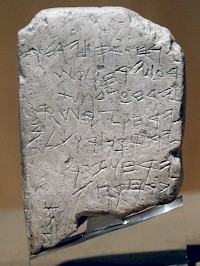Calendar, Jewish
Jewish Calendar: derived from a Babylonian model, the Jewish calendar combines lunar months and solar years, and is still in use.
The Jewish year consists of twelve months of each 29 or 30 days. A regular year, therefore, has 354 days and is about 11 days shorter than the solar year. Therefore, eight extra ("intercalary") months are added in a nineteen-year cycle. The system was adopted from the Babylonian calendar.
|
|
|
|
|
|
|
|
|
|
|
|
|
|
|
|
|
|
|
|
|
|
|
|
|
|
|
|

(The years with an X are years with a second Adar, and had, therefore, 383 days.) This calendar was c.360 CE introduced by patriarch Hillel II. In earlier centuries, intercalation was probably irregular, but it is not likely that this caused great discrepancies between the official and the solar calendar. After all, there were many religious festivals that were related to natural phenomena (e.g., the offering of the firstfruits of barley on 16 Nisan), and the authorities responsible for the intercalation had to keep the festivals in mind.
The sect at Qumran had another calendar that was designed to make sure that Passover would never be on a Sabbath. A similar measure can be found in the table below, in which the months of Marheshvan and Kislev can have either 29 or 30 days, an adjustment that is needed to prevent that Yom Kippur and the seventh day of Sukkot intervene with the Sabbath.
The Jews have two ways of counting their months. In the sacred calendar, Nisan is the first month (column 1); in the civil calendar, New Year is celebrated on the first day of Tishri (column 2). The third column gives the names of the months and the number of days; the fourth column mentions their equivalent in the western calendar. Column five gives the names of the most important religious festivals. The last column mentions the natural phenomena.
In the first centuries of the common era, the Jews discerned five seasons: harvest, hot season, seed time, winter and cold season.
|
|
|
|
|
|
|
|
|
|
Nisan 30 days |
March/April | 14. Passover (Pesah) 16. Firstfruits of barley |
Fall of the latter spring rains Barley ripe; planting sesame |
|
|
|
Iyyar 29 days |
April/May | 14. Second Passover (Pesah Sheni) 18. Lag BaOmer (commemoration of the end of second-century plague) |
Harvest of barley, peas, lentils Wheat ripens |
|
|
|
Sivan 30 days |
May/June | 6. Feast of Weeks (Shawu'ot) Firstfruits of wheat |
Harvest of wheat Begin of the summer (no rain until September) |
|
|
|
Tammuz 29 days |
June/July | Heat increases Harvest chickpeas, first harvest of figs |
|
|
|
|
Ab 30 days |
July/August | 9. Commemoration of the Fall of the Temple | The streams dry up Intense heat |
|
|
|
Elul 29 days |
August/September | Vintage of pomegranates and grapes; second harvest of figs |
|
|
|
|
Tishri 30 days |
September/October | 1. New Year (Rosh Hashanah) 10. Day of Atonement (Yom Kippur) 15-23. Feast of Tabernacles (Sukkot) Firstfruits of wine and oil |
Early rains Processing of grapes Plowing and sowing begins Olives |
|
|
|
Marheshvan 29/30 days |
October/November | Continuous rain Wheat, barley, and oats sown Vintage in Galilee |
|
|
|
|
Kislev 30/29 days |
November/December | 25. Feast of Dedication (Hanukah) | Begin of winter. Snow on the mountains Sowing peas, lentils, chicken peas, flax |
|
|
|
Tebeth 29 days |
December/January | Coldest month; hail, snow. |
|
|
|
|
Shebat 30 days |
January/February | 15. New Year of Trees | Weather becomes warmer Care for garden vegetables |
|
|
|
Adar 29 days |
February/March | 14. Feast of Purim (Megillah) | Thunder and hail frequent Almond trees blossom; planting millet |
Thanks...
... to Mr Leonard S. Berkowitz